For optimal dining room ambiance, designers recommend selecting bulbs within the 2700K-3000K range, which produces warm light that enhances food presentation and creates intimate gathering spaces. This temperature range intensifies red tones in cuisine while promoting relaxation and comfort. Modern dining rooms can accommodate slightly cooler 3000K-3500K temperatures, while traditional settings benefit from warmer 2700K options. Consistency across all fixtures prevents jarring contrasts that undermine spatial coherence. Advanced considerations reveal additional nuances for achieving professional-grade illumination.
Key Takeaways
- Choose 2700K-3000K for warm, intimate dining atmospheres that enhance food appeal and encourage relaxation.
- Match color temperature to your dining room style: traditional (2700K-3000K), modern (3000K-3500K), industrial (3000K-4000K).
- Ensure all fixtures use the same color temperature to maintain visual harmony and prevent jarring contrasts.
- Select bulbs with high CRI (≥90) to accurately represent food colors and enhance overall presentation.
- Test different bulbs within your preferred temperature range to find the best match for your room’s color palette.
Understanding Color Temperature and Its Impact on Dining Atmosphere

When selecting lighting for dining spaces, color temperature serves as the fundamental parameter that determines both visual comfort and atmospheric quality. Measured in Kelvin (K), this metric indicates whether light appears warm or cool, with lower values producing warmer tones and higher values generating cooler illumination.
Warm light ranging from 2,700-3,000K creates intimate, cozy environments that enhance food presentation and encourage relaxation. Conversely, cool light above 3,500K energizes spaces but may compromise food appeal and comfort.
Lighting psychology demonstrates that warmer temperatures promote conversation and extended dining experiences, while cooler temperatures increase alertness but can feel clinical. Additionally, warm lighting makes a room feel smaller than its actual size, creating a more intimate dining atmosphere. The strategic use of color temperature significantly influences guest perceptions and emotions throughout their dining experience. Understanding these color preferences enables designers to craft purposeful dining environments that align with intended atmosphere and guest behavior patterns.
The Science Behind Warm vs. Cool Light in Dining Spaces
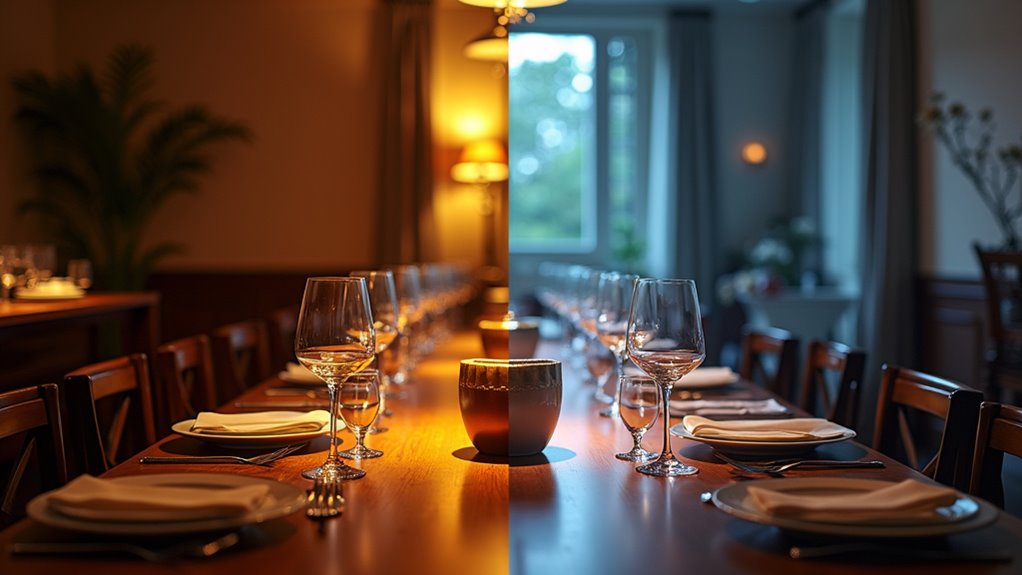
Although color temperature fundamentally shapes dining environments through measurable physical properties, the underlying science reveals complex interactions between light wavelengths and human physiology that directly influence dining experiences.
Warm light below 3000K triggers psychological responses associated with comfort and intimacy, while cool light above 4000K stimulates alertness through blue-spectrum wavelengths. This light perception mechanism affects circadian rhythms, with warm temperatures promoting melatonin production essential for evening relaxation.
Warm lighting below 3000K naturally promotes melatonin production, creating the physiological foundation for intimate dining experiences through evolutionary comfort responses.
Research demonstrates that warmth preference stems from evolutionary associations with fire and candlelight, creating subconscious comfort responses.
Cool lighting enhances visual acuity through improved contrast ratios but may induce eye strain during extended dining periods. Understanding these physiological mechanisms enables designers to strategically manipulate color temperature for optimal dining atmosphere creation.
Additionally, Color Rendering Index ratings above 90 ensure accurate representation of food colors, making warm-toned dishes appear more appetizing under proper lighting conditions.
Optimal Color Temperature Ranges for Different Dining Room Styles
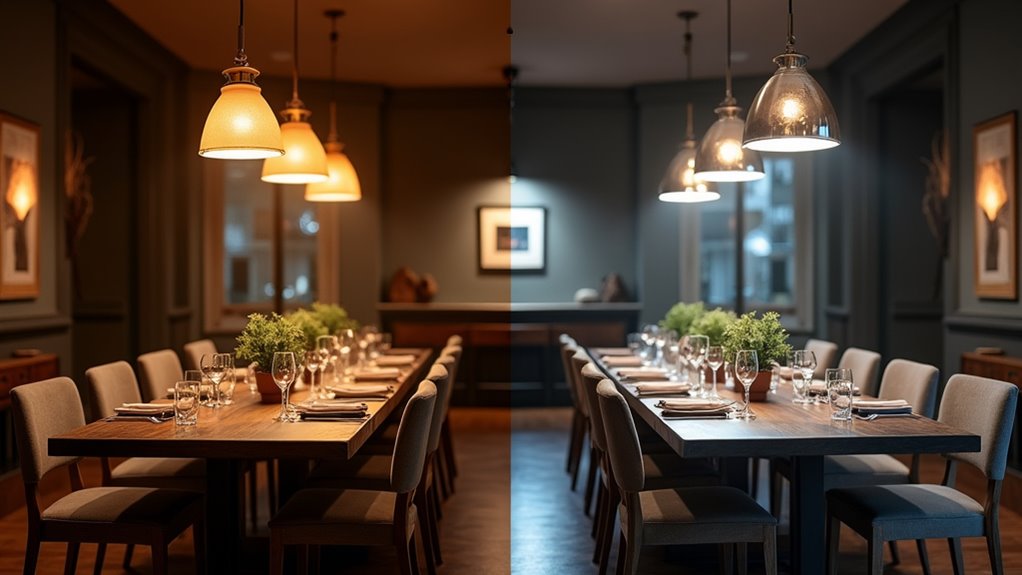
Since dining room aesthetics fundamentally depend on complementary lighting choices, specific color temperature ranges align with distinct interior design styles to optimize both visual appeal and functional performance.
Strategic dining style pairings ensure cohesive atmospheric design while maintaining lighting fixture compatibility across multiple elements.
Traditional and elegant spaces benefit from 2700K-3000K temperatures, producing golden illumination that enriches classic wood furnishings.
Modern contemporary designs accommodate 3000K-3500K ranges, balancing warmth with clean architectural lines.
Industrial aesthetics support cooler 3000K-4000K temperatures that complement exposed materials like brick and metal.
Craftsman-style dining rooms particularly benefit from warmer 2700K-3000K temperatures that enhance the amber glass shades and handcrafted wood elements characteristic of Arts and Crafts design.
- Traditional/Elegant: 2700K-3000K enhances classic materials and fabric textures
- Modern/Contemporary: 3000K-3500K balances warmth with metallic accents
- Rustic/Country: 2700K-3000K complements natural wood and earth elements
- Industrial: 3000K-4000K matches concrete and exposed structural features
- Eclectic/Mixed: Layered approach using 2700K-3500K for design versatility
How Light Color Affects Food Presentation and Appetite
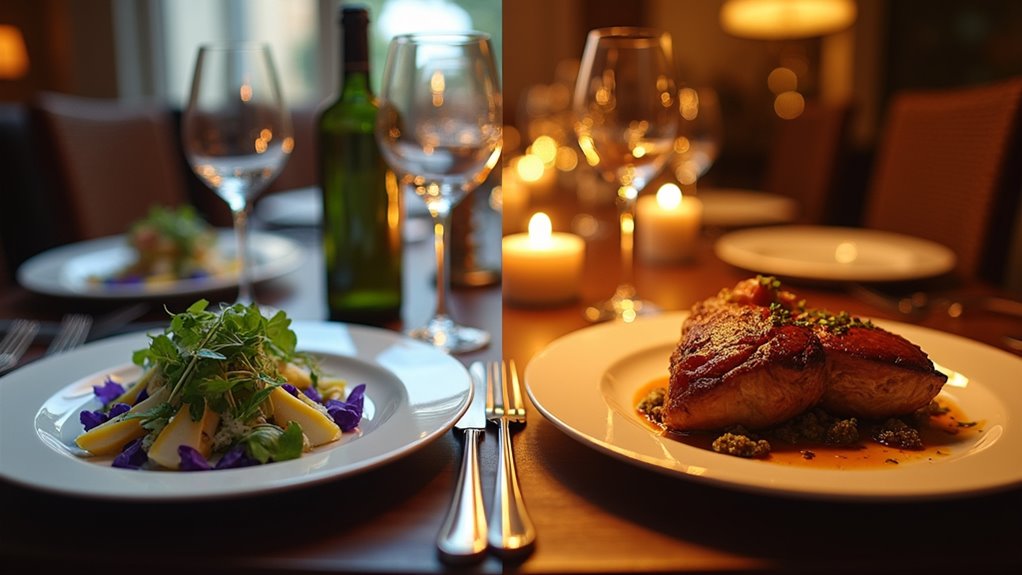
Beyond creating atmospheric ambiance, lighting color temperature profoundly influences how food appears and how diners psychologically respond to their meals.
Warm temperatures between 2700K-3000K enhance food appeal by intensifying red tones in meats and creating golden highlights in baked goods and cheeses. High Color Rendering Index bulbs (CRI ≥90) reproduce authentic food colors, preventing the washed-out appearance that diminishes visual quality.
Research demonstrates that warm lighting generates positive emotional response patterns, increasing purchase intent and extending dining duration.
Cool temperatures above 4000K effectively showcase whites and greens but may reduce the appeal of hot, rich foods.
The optimal range of 3000K-3500K provides versatile food presentation while maintaining authentic color reproduction across diverse culinary presentations. Modern dimmable LED lights offer stepless dimming capabilities that allow you to fine-tune these color temperatures throughout your meal, transitioning seamlessly from bright task lighting during food preparation to softer ambient lighting during dining.
Creating Flexible Lighting With Dimmers and Smart Controls
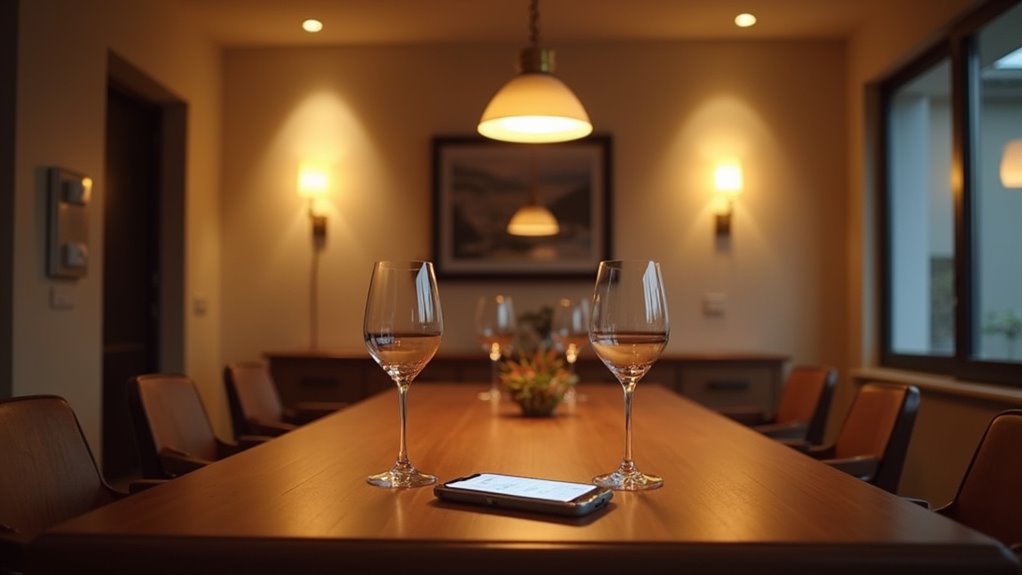
Modern dining rooms demand lighting systems that adapt seamlessly to varying occasions, meal types, and time-sensitive requirements. Dimmer versatility enables precise brightness control, transitioning from intense illumination for meal preparation to subdued ambiance for intimate dining experiences.
Adaptable dining room lighting transforms spaces instantly, delivering precise brightness control for every occasion from functional meal prep to romantic dinner settings.
Smart adjustments through programmable schedules and remote connectivity provide sophisticated automation capabilities that enhance both functionality and energy efficiency.
Contemporary dimming solutions offer comprehensive control over dining room atmospheres:
- Remote control capabilities via mobile applications allow lighting adjustments from any location within the home
- Voice assistant integration with Alexa, Google Assistant, or Siri enables hands-free operation during meal service
- Programmable scheduling automatically adjusts brightness levels based on time of day or specific dining events
- Energy conservation reduces electricity consumption by 5-25% while extending bulb lifespan through reduced electrical stress
- Layered lighting coordination seamlessly integrates with accent and pendant fixtures for versatile mood customization
Common Color Temperature Mistakes That Ruin Dining Room Ambiance
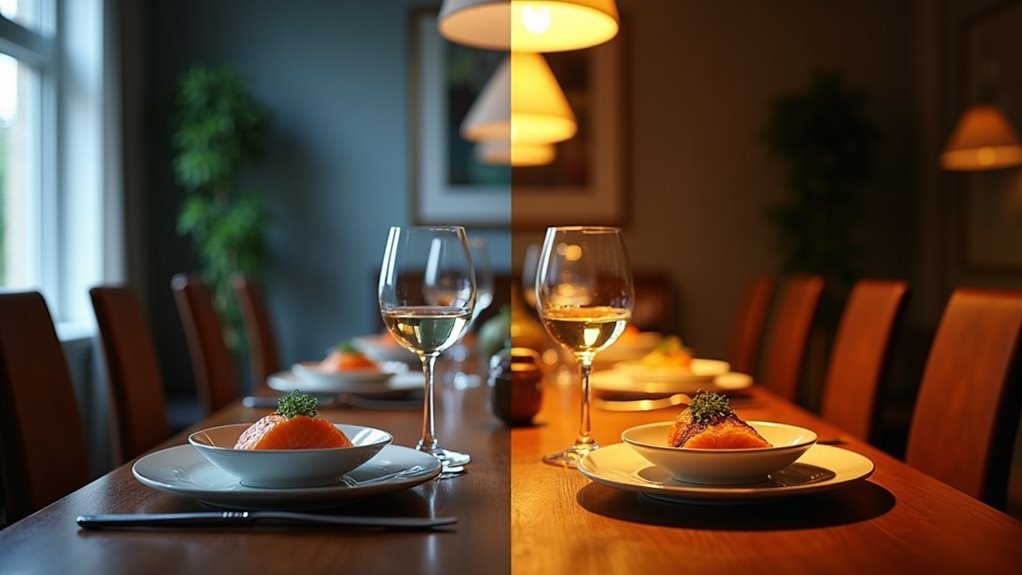
Precision in color temperature selection distinguishes professionally designed dining spaces from amateur lighting installations that inadvertently sabotage atmospheric goals.
Mixing warm white (2700K) and cool white (3500K) bulbs within the same room creates jarring contrasts that generate dining discomfort and undermine spatial coherence. Professional designers maintain uniform color temperature across all fixtures, selecting ranges between 2700K-3000K for optimal ambiance.
Cooler temperatures above 3500K produce harsh, unwelcoming illumination inappropriate for intimate dining settings. These stark conditions detract from meal presentation and guest comfort.
Additionally, color temperature affects decor perception—warmer tones enhance reds and oranges while cooler temperatures wash out complementary hues. Inconsistent temperatures between adjacent rooms create disjointed transitions that strain occupant visual comfort and compromise seamless spatial flow throughout connected areas.






